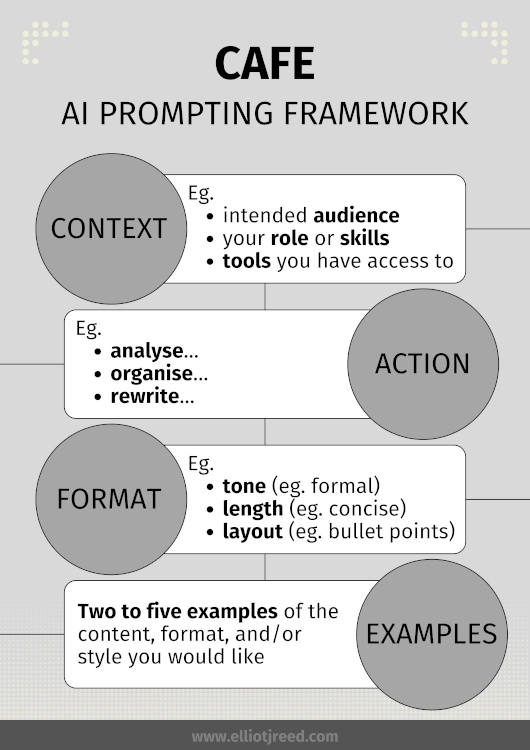CAFE Prompt Framework
This is an outline of my CAFE prompt framework. For a more in-depth guide, take a look at my AI Prompt Engineering Guide.

Feel free to download the poster as a PNG image, or in PDF format.
Context
This could include:
- the intended audience
- your skills or area of expertise
- your job role
- the tools, software, or equipment you have access to
Action
Use active verbs to describe the task. Eg.
- act as…
- analyse…
- create…
- organise…
- summarise…
Use "active criteria" over "negative constraints". Eg. "include only details about the camera resolution, screen size, processor, and memory" rather than "do not include details about battery life, available apps, or charging capabilities".
Format
This can include information such as:
- tone (eg. use a professional tone)
- length (eg. keep it short and quick to read)
- medium (eg. in the medium of a business memo)
- layout (eg. use bullet points and clear headings)
Examples
Provide two to five examples where possible. Eg. if you want to generate a social media post, provide examples of ones you like.
Iterate
Iterate on the response. This could include:
- requesting a change in tone
- clarifying a point
- pointing out an error
- asking for a more concise output
- re-writing as a similar task (eg. instead of "analyse the report for social media trends in 2025" you could re-write as "identify key trends in social media marketing from the 2025 report")
Example Prompts
Here are three examples using the CAFE framework. The order of the CAFE elements doesn't matter (for example, the action could come before the context, or the format after the examples).
Garden Planning for Small Space
Context: I live in a terraced house in Manchester with a north-facing garden that's approximately 3m x 5m. The space gets limited direct sunlight except in summer mornings. The soil is clay-heavy and tends to waterlog during winter months.
Action: Design a low-maintenance garden plan that incorporates edible plants, year-round visual interest, and creates habitat for local wildlife like birds and pollinators.
Format: Provide a visual layout description with seasonal planting recommendations. Include a short shopping list of essential plants and materials, and a monthly maintenance calendar.
Examples: My neighbour created a successful small garden using raised beds to overcome poor drainage, and my sister incorporated vertical growing spaces with trellises to maximise her limited garden footprint.
Family History Research Strategy
I'm researching my family history and have hit a roadblock with my maternal great-grandfather. I know he was born around 1885 in Glasgow and worked as a shipbuilder, but I've found conflicting information about his parents and siblings.
Outline a systematic research strategy to verify his parentage and siblings. Recommend specific archives, databases, or resources I should consult.
Create a detailed research plan organised by source type, with specific questions to investigate for each source. Include troubleshooting tips for common problems like name variations or missing records.
When researching my paternal line, I successfully broke through a similar roadblock by examining church parish records and local newspaper archives for marriage announcements.
Family History Research Strategy
I'm a volunteer at a local primary school and will be giving a 30-minute presentation to Year 4 pupils (ages 8-9) about climate change. Most children have some awareness of the topic but limited understanding of the science.
Create an age-appropriate explanation of climate change with interactive elements to maintain engagement. Include key concepts that children should understand by the end.
Structure the presentation with a simple introduction, 3-4 core concepts, and a hopeful conclusion with actions children can take. Include suggestions for simple demonstrations or activities that require minimal materials.
Previous successful presentations to this age group have used the "greenhouse as a blanket" analogy and incorporated sorting activities where children categorised everyday actions as "helps the planet" or "harms the planet."